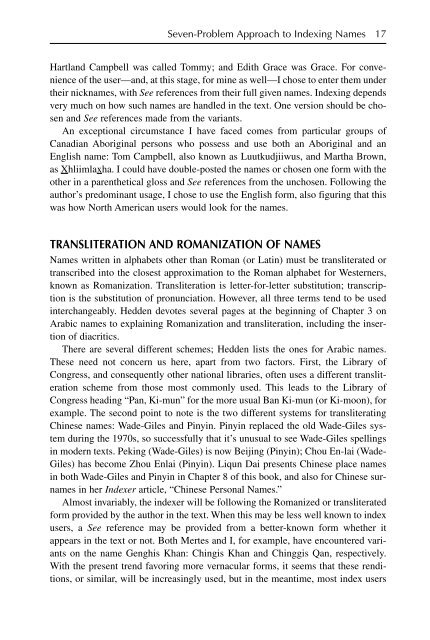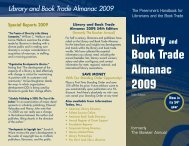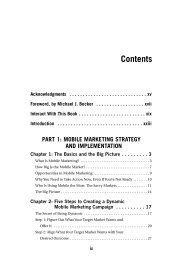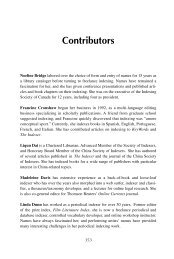Sample Chapter - Books
Sample Chapter - Books
Sample Chapter - Books
- No tags were found...
Create successful ePaper yourself
Turn your PDF publications into a flip-book with our unique Google optimized e-Paper software.
Seven-Problem Approach to Indexing Names 17Hartland Campbell was called Tommy; and Edith Grace was Grace. For convenienceof the user—and, at this stage, for mine as well—I chose to enter them undertheir nicknames, with See references from their full given names. Indexing dependsvery much on how such names are handled in the text. One version should be chosenand See references made from the variants.An exceptional circumstance I have faced comes from particular groups ofCanadian Aboriginal persons who possess and use both an Aboriginal and anEnglish name: Tom Campbell, also known as Luutkudjiiwus, and Martha Brown,as Xhliimlaxha. I could have double-posted the names or chosen one form with theother in a parenthetical gloss and See references from the unchosen. Following theauthor’s predominant usage, I chose to use the English form, also figuring that thiswas how North American users would look for the names.TRANSLITERATION AND ROMANIZATION OF NAMESNames written in alphabets other than Roman (or Latin) must be transliterated ortranscribed into the closest approximation to the Roman alphabet for Westerners,known as Romanization. Transliteration is letter-for-letter substitution; transcriptionis the substitution of pronunciation. However, all three terms tend to be usedinterchangeably. Hedden devotes several pages at the beginning of <strong>Chapter</strong> 3 onArabic names to explaining Romanization and transliteration, including the insertionof diacritics.There are several different schemes; Hedden lists the ones for Arabic names.These need not concern us here, apart from two factors. First, the Library ofCongress, and consequently other national libraries, often uses a different transliterationscheme from those most commonly used. This leads to the Library ofCongress heading “Pan, Ki-mun” for the more usual Ban Ki-mun (or Ki-moon), forexample. The second point to note is the two different systems for transliteratingChinese names: Wade-Giles and Pinyin. Pinyin replaced the old Wade-Giles systemduring the 1970s, so successfully that it’s unusual to see Wade-Giles spellingsin modern texts. Peking (Wade-Giles) is now Beijing (Pinyin); Chou En-lai (Wade-Giles) has become Zhou Enlai (Pinyin). Liqun Dai presents Chinese place namesin both Wade-Giles and Pinyin in <strong>Chapter</strong> 8 of this book, and also for Chinese surnamesin her Indexer article, “Chinese Personal Names.”Almost invariably, the indexer will be following the Romanized or transliteratedform provided by the author in the text. When this may be less well known to indexusers, a See reference may be provided from a better-known form whether itappears in the text or not. Both Mertes and I, for example, have encountered variantson the name Genghis Khan: Chingis Khan and Chinggis Qan, respectively.With the present trend favoring more vernacular forms, it seems that these renditions,or similar, will be increasingly used, but in the meantime, most index users








